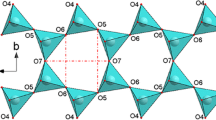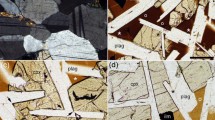Abstract
Antiphase domains (APD's) of pigeonite lamellae in natural and heated augite crystals from the Hakonetoge andesite have been examined by a transmission electron microscope (TEM). Antiphase boundaries (APB's) of the pigeonite lamellae in natural specimens have a sigmoidal shape cutting the c axis in (010) sections. APB's in specimens heated at temperatures above the high-low inversion and then quenched are nearly parallel to the c axis with almost straight boundaries. These observations indicate that the preferred orientation of APB's in (010) sections depends on cooling rate; at fast colling rates the APB's are nearly parallel to the c axis, whereas at slower cooling rates they are inclined to the c axis.
The cooling rate of the natural augite specimen from Hakonetoge is estimated to be about 0.01 °C/h from the experimentally determined time-temperature-transformation (TTT) diagram for the APB orientations.
APD sizes are large in specimens quenched from above the inversion temperature; they are at a minimum after cooling rates of around 1–0.1 °C/h, and then become larger with slower cooling rates.
Similar content being viewed by others
References
Baily JC, Champness PE, Dunham AC, Esson J, Fyfe WS, Mackenzie WS, Stumpfl EF, Zussman J (1970) Mineralogy and petrology of Apollo 11 lunar samples. Proc Apollo 11 Lunar Sci Conf:169–194
Carpenter MA (1978) Nucleation of augite at antiphase boundaries in pigeonite. Phys Chem Minerals 2:237–251
Carpenter MA (1979a) Contrasting properties and behavior of antiphase domains in pyroxenes. Phys Chem Minerals 5:119–131
Carpenter MA (1979b) Experimental coarsening of antiphase domains in a silicate mineral. Science 206:681–683
Champness PE, Lorimer GW (1972) Electron microscopic studies of some lunar and terrestrial pyroxenes. Proc 5th Int Mater Sym Berkeley: University of California Press, pp 1245–1255
Christie JM, Lally JS, Heuer AH, Fisher RM, Griggs DT, Radcliffe SV (1971) Comparative electron petrography of Apollo 11, Apollo 12, and terrestrial rocks. Proc 2nd Lunar Sci Conf Geochim Cosmochim Acta [Suppl] 2, 1:69–89
Grove TL (1979) An experimental calibration of submicroscopic textures in lunar pyroxenes: a transmission electron microscope study. Lunar Planet Sci X:467–469
Jaeger JC (1968) Cooling and solidification of igneous rocks. In: Hess HH and Poldervaart A (ed) Basalts: The Poldervaart Treatise on Rocks of Basaltic Composition, Vol 2. Wiley-Interscience, New York, pp 503–537
Kuno H (1936) Petrological notes on some pyroxene-andesites from Hakone volcano, with special reference to some types with pigeonite phenocrysts. Jpn J Geol Geogr 13:107–140
Morimoto N, Tokonami M (1969) Domain structure of pigeonite and clinoenstatite. Am Mineral 54:725–740
Putnis A, McConnell JDC (1980) Principles of mineral behavior. Blackwell Scientific Publications, Oxford London Edinburgh Boston Melbourne
Author information
Authors and Affiliations
Rights and permissions
About this article
Cite this article
Fujino, K., Furo, K. & Momoi, H. Preferred orientation of antiphase boundaries in pigeonite as a cooling ratemeter. Phys Chem Minerals 15, 329–335 (1988). https://doi.org/10.1007/BF00311037
Received:
Issue Date:
DOI: https://doi.org/10.1007/BF00311037




